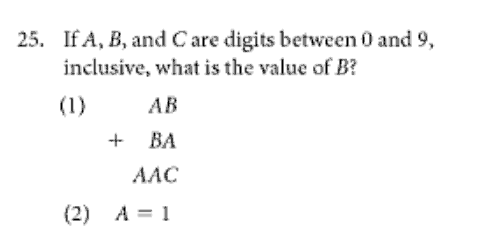Events & Promotions
|
|

GMAT Club Daily Prep
Thank you for using the timer - this advanced tool can estimate your performance and suggest more practice questions. We have subscribed you to Daily Prep Questions via email.
Customized
for You
Track
Your Progress
Practice
Pays
Not interested in getting valuable practice questions and articles delivered to your email? No problem, unsubscribe here.
- Nov 20
07:30 AM PST
-08:30 AM PST
Learn what truly sets the UC Riverside MBA apart and how it helps in your professional growth - Nov 20
01:30 PM EST
-02:30 PM IST
Learn how Kamakshi achieved a GMAT 675 with an impressive 96th %ile in Data Insights. Discover the unique methods and exam strategies that helped her excel in DI along with other sections for a balanced and high score. - Nov 19
12:30 PM EST
-01:30 PM EST
Learn how Keshav, a Chartered Accountant, scored an impressive 705 on GMAT in just 30 days with GMATWhiz's expert guidance. In this video, he shares preparation tips and strategies that worked for him, including the mock, time management, and more - Nov 22
11:00 AM IST
-01:00 PM IST
Do RC/MSR passages scare you? e-GMAT is conducting a masterclass to help you learn – Learn effective reading strategies Tackle difficult RC & MSR with confidence Excel in timed test environment - Nov 23
11:00 AM IST
-01:00 PM IST
Attend this free GMAT Algebra Webinar and learn how to master the most challenging Inequalities and Absolute Value problems with ease. - Nov 24
07:00 PM PST
-08:00 PM PST
Full-length FE mock with insightful analytics, weakness diagnosis, and video explanations! - Nov 25
10:00 AM EST
-11:00 AM EST
Prefer video-based learning? The Target Test Prep OnDemand course is a one-of-a-kind video masterclass featuring 400 hours of lecture-style teaching by Scott Woodbury-Stewart, founder of Target Test Prep and one of the most accomplished GMAT instructors.
Kudos
Bookmarks
A
Be sure to select an answer first to save it in the Error Log before revealing the correct answer (OA)!
Difficulty:
 75%
(hard)
75%
(hard)
Question Stats:
53% (01:49) correct 47%
(01:54)
wrong
47%
(01:54)
wrong  based on 345
sessions
based on 345
sessions
History
Date
Time
Result
Not Attempted Yet
If A, B and C are digits between 0 and 9 inclusive, what is the value of B?
(1) AB + BA = AAC
(2) A = 1.

Kaplan.png [ 20.26 KiB | Viewed 9827 times ]
Kaplan Math Workbook (6th Edition) official answer states:
statement 1:
that a sum of a two-digit number plus another two-digit number gives a three-digit number. The sum of 2 two-digit numbers must be less that 200, therefore A must be 1.
Then it concludes that this statement is true only when b=9 ----> Sufficient
Statement 2 is Insufficient (obviously) and therefore the AC is A.
Evaluating the red phrase: it assumes that A and B must be two-digit numbers. Isn't it possible that A=0? Isn't the following addition correct? (B has to equal 0 for it to be correct, but still...)
+ 0 B
+ B 0
-------
0 0 B
Or because no one writes the 0's therefore it implies that A and B can't equal 0?
I would really appreciate any comments.
(1) AB + BA = AAC
(2) A = 1.
Attachment:
Kaplan.png [ 20.26 KiB | Viewed 9827 times ]
Kaplan Math Workbook (6th Edition) official answer states:
statement 1:
that a sum of a two-digit number plus another two-digit number gives a three-digit number. The sum of 2 two-digit numbers must be less that 200, therefore A must be 1.
Then it concludes that this statement is true only when b=9 ----> Sufficient
Statement 2 is Insufficient (obviously) and therefore the AC is A.
Evaluating the red phrase: it assumes that A and B must be two-digit numbers. Isn't it possible that A=0? Isn't the following addition correct? (B has to equal 0 for it to be correct, but still...)
+ 0 B
+ B 0
-------
0 0 B
Or because no one writes the 0's therefore it implies that A and B can't equal 0?
I would really appreciate any comments.
Kudos
Bookmarks
SonyGmat
I think one thing we can assume safely is that A, B and C are distinct digits.
Next, even if we don't assume that A>0 (because of AB and AAC as you mention) then still A can not be zero as 0B+B0=00C doesn't hold true for any values of B and C (single digit number B plus two-digit number B0 can not equal to C, also a single digit number).
If A, B and C are digits between 0 and 9 inclusive, what is the value of B?
(1) AB + BA = AAC --> well from above A=1 (A can not be more than 1, as the sum of 2 two-digit numbers is always less than 200) --> 1B+B1=11C --> B=9 (B can not be less than 8 as 18+81=99, not a three digit number) --> 19+91=110. Sufficient.
(2) A = 1. Not sufficient.
Answer: A.
Hope it helps.
General Discussion
Kudos
Bookmarks
Bunuel
Thanks for your post Bunuel! +1
why should we assume that they are distinct digits?
Let me try to illustrate my point with another example:
Can the sum of two prime numbers, A and B, be an even number?
Of course it can. If a=b=2 then 2+2=4. It doesn't state that x and y are distinct values, therefore to my understanding, I can assume that they could have the same value.
Now back to my post:
Since the question stem doesn't state that A,B,C are distinct values, why should we assume it? isn't it possible for A=B=C=0?













